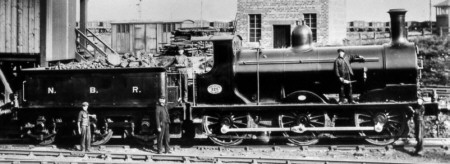The Holmes J33 (NBR Class D) 0-6-0 Locomotives

Drummond built the successful general purpose J34 in large numbers for the North British Railway (NBR). On succeeding Drummond, Holmes adapted the design slightly, before introducing his larger 18in cylinder J36. The NBR classed the adapted locomotives as Class D, and the LNER classed them as J33. A total of thirty six J33s were built in five batches between 1883 and 1887.
The primary difference between the J34 and the J33, was the use of a level grate instead of a sloping grate. This change required a small increase (from 7ft 9in to 8ft) in the wheel spacing between the middle and rear axles. There were also a number of differences between the individual batches. The first batch of twelve J33s had tender springs below the axles, but later locomotives had them above the axles. The first twenty four J33s had Drummond cabs, whilst the last twelve had Holmes cabs. The last six also had an angle iron fitted to the tender footplate.
The entire class was rebuilt with new boilers between 1908 and 1913, but their external appearance barely changed. The different cab variations survived the rebuilds. The new boilers replaced the original non-lifting injectors with faceplate injectors.
After the J34s were rebuilt, they closely resembled the J33s fitted with Drummond cabs. Despite the firebox and wheel spacing differences, even Cowlairs appears to have had trouble distinguishing them at times. At least two J33s were incorrectly marked as "J34" when repainted in 1925-6.
None of the J33 tenders were built with coal rails, but they all received them during the tenures of Holmes or Reid. When the J33s were operating as bankers, they often ran tender first along exposed stretches of line. To help protect the crews from poor weather, five J33s received tender cabs and two received tender weatherboards.
The J33s could usually be found at most of the NBR's main sheds. Initially they were used on secondary main line goods, but over time they were moved to local services. Some were fitted with continuous brakes, and during busy periods these were used on suburban passenger services in the Edinburgh and Glasgow areas.
By Grouping (1923), the J33s were mainly being used on trip pilot duties and local coal trains. The allocation at this time was: Hawick (6), Kipps (6), St. Margaret's (5), Parkhead (4), Polmont (4), Burntisland (3), Carlisle (2), Thornton (2), Bathgate (2), Eastfield (1), and Dunfermline (1). After Grouping, Nos. 9021 and 9249 were moved to Kipps. They were cut down to operate the Gartverrie branch, and operated the Gunnie and Glenboig daily goods train. No. 9169 was moved to St. Margaret's to operate the Portobello and Gifford pick-up goods. No. 9169 operated this service so often, that the booked times were scratched into the paintwork in its cab! Withdrawals started in 1924, and only Nos. 9249 & 9159 were still operating at the end of 1932. These last two J33s were withdrawn in 1938.
Technical Details
| Cylinders (x2): | (inside) | 17x26in. |
| Motion: | Stephenson | |
| Valves: | slide | |
| Boiler: | Max. Diameter: | 4ft 5in |
| Pressure: | 150psi | |
| Diagram No.: | 84 | |
| Heating Surface: | Total: | 1059 sq.ft. |
| Firebox: | 100 sq.ft. | |
| Tubes: | 959 sq.ft. (202x 1.75in) | |
| Grate Area: | 17 sq.ft. | |
| Wheels: | Coupled: | 5ft |
| Tender: | 4ft | |
| Tractive Effort: | (@ 85% boiler pressure) | 15,967lb |
| Wheelbase: | Total: | 36ft 0in |
| Engine: | 15ft 6in | |
| Tender: | 12ft 0in | |
| Weight (full): | Total: | 69 tons 16cwt |
| Engine: | 37 tons 16cwt | |
| Tender: | 32 tons 0cwt | |
| Max. Axle Load: | 15 tons 10cwt |
Preservation
None of the J33s survived into preservation.
Models
I am not aware of any models of the J33s in any scale.
Acknowledgments
Thank you to Malcolm Peirson for the photograph of NBR No. 128.